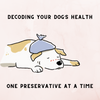
How permitted preservatives can be ruining your dog's life
, by The Pet Belly, 7 min reading time

, by The Pet Belly, 7 min reading time

Why do some dogs live well above the age of 15 whereas some don’t even make it to double digits? You’d think the answer would be genetics, breeding techniques, some unforeseen disease, but more often than not, it’s simply LIFESTYLE.
An ideal lifestyle for dogs has 3 essential quotients:
Nutrition is the most crucial one. As educated humans, we understand that nutrition is a well-balanced metric of various food components that give us all essential nutrients necessary to live. So, we are told this answer for dogs is kibble. We are told that they pack all the essential nutrients in the correct balances to give overall nutrition.
We then nit-pick the brands we use and whoever seems fresher, fancier, easier, we opt for that. International brands are better, because they must be safer… Or so we are made to think.
Now, kibble in itself isn’t a bad word or item. You just need to be vary of what you're choosing. Some have 20% chicken and 80% fillers, some have 80% chicken and 20% fillers. On the basis of availability and price point, you will choose the best for you and your pet. The problem is no matter what the ratio of food to fillers are, there are always preservatives.
Preservatives play a crucial role in ensuring the safety and shelf-life of dog food, that’s what makes it easy to store and feed for years to come. But artificial and chemical-based preservatives, found in almost all commercial dog food, have been scrutinized for their potential health implications. They are known but approved for use by the FSSAI, by the FDA, by the EFSA, and I’m sure everyone else who is relevant. Everything written below can be googled, checked on these specific food safety unions’ websites and the answers will be the same.

Artificial Preservatives:
Artificial preservatives, such as BHA (butylated hydroxyanisole) and BHT (butylated hydroxytoluene), are synthetic compounds added to dog food to prevent spoilage and extend shelf life.
BHA and BHT have also been linked to various health concerns in dogs, including allergic reactions, digestive issues and cancer. Studies have shown that these preservatives may accumulate in the body over time, potentially leading to chronic health problems. Some dogs may be naturally more sensitive to these toxins, succumbing to their adverse reactions sooner.

Chemical-Based Preservatives:
Chemical-based preservatives, such as ethoxyquin, propylene glycol, and sodium nitrite, (wow, it’s tough to pronounce half of these, wonder how our babies are supposed to digest these!) are also commonly used in dog food to prevent spoilage and maintain product quality. While these preservatives are not artificial per say, they, too, come with their own set of potential health risks!
Ethoxyquin, for example, has been associated with liver and kidney damage in dogs, particularly when consumed in large quantities over an extended period.
Propylene glycol, (also a common ingredient in antifreeze- used in car engines- toxic for human consumption), has been linked to neurological issues and digestive upset in dogs.
Sodium nitrite, often used as a color fixative, can react with other compounds in dog food to form harmful substances known as nitrosamines, which are carcinogenic.
Long-Term Effects on Dogs:
Chronic exposure to these additives may compromise the immune system, disrupt hormone balance, and contribute to the development of chronic diseases, including cancer, diabetes, and obesity. Additionally, some dogs may experience allergic reactions or intolerance to these preservatives, leading to skin problems, gastrointestinal discomfort, and other health issues.

The Simpler ‘Preservatives”
When you start reading the back of the food, treats, and biscuit packets, you’ll soon notice 2 other ingredients, which are typically not allowed for pets.
Now, these are the trickier ingredients. Sodium and glucose are both needed by dogs, but in very small quantities. It is usually derived naturally from the foods they eat. So, anything excess or on top, can lead to a whole new plethora of problems.
Salt poisoning in dogs may include vomiting, diarrhea, excessive thirst, dehydration, lethargy, tremors, seizures, and even death in severe cases. Certain medical conditions, such as kidney disease or heart disease, can increase a dog's sensitivity to salt and exacerbate the risk of salt poisoning.
Sugary treats and foods high in refined sugars can contribute to obesity in dogs, which is a significant health concern associated with various secondary conditions, such as diabetes, joint problems, heart disease, and decreased lifespan. Sugary foods may cause spikes in a dog's blood sugar levels, leading to energy crashes and mood swings.
Xylitol, a sugar substitute commonly found in sugar-free gum, candies, and baked goods, is extremely toxic to dogs. Ingesting even small amounts of xylitol can cause rapid insulin release, leading to hypoglycemia (low blood sugar), seizures, liver failure, and death.
Choosing Safer Alternatives:
Foods with artificial and chemical preservatives are dangerous. So why don’t more companies ditch these preservatives and choose natural or other preservation techniques? Because it becomes expensive. And their lives are already easy and in full swing!

So, what can you do for your furry child? You can opt for foods preserved naturally with air drying, freeze drying, vacuum packaging, etc which are just air based technologies which retains the freshness of the food but mostly doesn’t add any chemicals to the food!
Some products also opt for natural preservatives, such as tocopherols (vitamin E), ascorbic acid (vitamin C), and rosemary extract!
So the next time you’re shopping for your pets, make sure you’re reading the back of your packets.
Find reading cumbersome, then just shop from a brand that does the reiki for you- The Pet Belly; a curated marketplace ONLY selling pet food products that are naturally preserved.
Honestly, some items aren’t preserved at all, and will go bad after their said dates. But that’s how you know it’s fresh!
